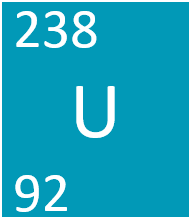Difference between revisions of "Uranium"
| Line 38: | Line 38: | ||
: [[Uranium]] is [[sonorous]]. | : [[Uranium]] is [[sonorous]]. | ||
: [[Uranium]] is [[ductile]]. | : [[Uranium]] is [[ductile]]. | ||
| + | |||
| + | ===References=== | ||
| + | ====AQA==== | ||
| + | |||
| + | :[https://www.amazon.co.uk/gp/product/178294558X/ref=as_li_tl?ie=UTF8&camp=1634&creative=6738&creativeASIN=178294558X&linkCode=as2&tag=nrjc-21&linkId=f0dfb66dafcb0c6e9449e7b1a4ae1ac476 ''Uranium, pages 18, 21, 49, GCSE Physics; The Revision Guide, CGP, AQA ''] | ||
| + | :[https://www.amazon.co.uk/gp/product/0008158770/ref=as_li_tl?ie=UTF8&camp=1634&creative=6738&creativeASIN=0008158770&linkCode=as2&tag=nrjc-21&linkId=ec31595e720e1529e49876c3866fff6e ''Uranium, pages 276-7, GCSE Physics; Student Book, Collins, AQA ''] | ||
| + | :[https://www.amazon.co.uk/gp/product/019835939X/ref=as_li_tl?ie=UTF8&camp=1634&creative=6738&creativeASIN=019835939X&linkCode=as2&tag=nrjc-21&linkId=57e96876985fc39b1a3d8a3e3dc238b6 ''Uranium, pages 37, 104-105, GCSE Physics; Third Edition, Oxford University Press, AQA ''] | ||
| + | :[https://www.amazon.co.uk/gp/product/1782946403/ref=as_li_tl?ie=UTF8&camp=1634&creative=6738&creativeASIN=1782946403&linkCode=as2&tag=nrjc-21&linkId=32a0abb60dff015b15b50e9b1d7b4644 ''Uranium, pages 45, 55, GCSE Combined Science Trilogy; Physics, CGP, AQA ''] | ||
| + | :[https://www.amazon.co.uk/gp/product/1782945970/ref=as_li_tl?ie=UTF8&camp=1634&creative=6738&creativeASIN=1782945970&linkCode=as2&tag=nrjc-21&linkId=a120d24dcc7cc7a58192069a3aafc1d2 ''Uranium, pages 47, 57, 140, GCSE Physics; The Complete 9-1 Course for AQA, CGP, AQA ''] | ||
| + | :[https://www.amazon.co.uk/gp/product/0008158770/ref=as_li_tl?ie=UTF8&camp=1634&creative=6738&creativeASIN=0008158770&linkCode=as2&tag=nrjc-21&linkId=ec31595e720e1529e49876c3866fff6e ''Uranium-235, pages 128-9, GCSE Physics; Student Book, Collins, AQA ''] | ||
Revision as of 16:09, 14 November 2019
Contents
Key Stage 2
Meaning
Key Stage 3
Meaning
Uranium is a Actinide metal element, on the Periodic Table, with an atomic number of 92.
About Uranium
Molecular Structure
- Uranium has the chemical symbol U.
- Uranium atoms join together in large numbers to form a giant metal molecule.
Atomic Structure
- Uranium as 92 protons and 146 neutrons in its nucleus giving it an Atomic Number of 92 and an atomic mass of 238.
- Uranium is in Period 7 of the Periodic Table because it has 7 electron shells.
Properties
- Uranium is a metal element so it is a good thermal conductor and a good electrical conductor.
- Uranium is a shiny solid at room temperature.
- Uranium is malleable.
- Uranium is sonorous.
- Uranium is ductile.
Key Stage 4
Meaning
Uranium is a Actinide metal element, on the Periodic Table, with 92 protons in the nucleus.
About Uranium
Molecular Structure
- Uranium has the chemical formula U.
- Uranium atoms join together in a giant metallic structure.
Atomic Structure
- The most stable isotope of Uranium has 146 neutrons in its nucleus giving it an atomic mass of 238.
- Uranium is in Period 7 of the Periodic Table because it has 7 electron shells.
- Uranium loses electrons to form positive metal ions.
Properties
- Uranium forms ionic bonds with non-metals.
- Uranium is a metal element so it is a good thermal conductor and a good electrical conductor.
- Uranium is a shiny solid at standard temperature and pressure and has a high melting point.
- Uranium is malleable.
- Uranium is sonorous.
- Uranium is ductile.
References
AQA
- Uranium, pages 18, 21, 49, GCSE Physics; The Revision Guide, CGP, AQA
- Uranium, pages 276-7, GCSE Physics; Student Book, Collins, AQA
- Uranium, pages 37, 104-105, GCSE Physics; Third Edition, Oxford University Press, AQA
- Uranium, pages 45, 55, GCSE Combined Science Trilogy; Physics, CGP, AQA
- Uranium, pages 47, 57, 140, GCSE Physics; The Complete 9-1 Course for AQA, CGP, AQA
- Uranium-235, pages 128-9, GCSE Physics; Student Book, Collins, AQA
